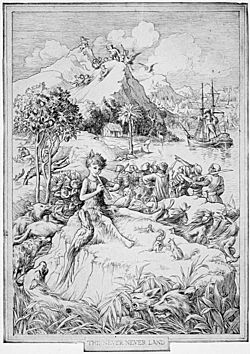Peter Pan syndrome facts for kids
Quick facts for kids Peter Pan syndrome |
|
|---|---|

Illustration of Peter Pan playing the pipes, by F. D. Bedford from Peter and Wendy
|
|
| Classification and external resources | |
| Specialty | Lua error in Module:Wikidata at line 70: attempt to index field 'wikibase' (a nil value). |
| Patient UK | Peter Pan syndrome |
Peter Pan syndrome describes one's inability to believe that they are of an older age or to engage in behaviour usually associated with adulthood. This syndrome affects people who do not want or feel unable to grow up, people with the body of an adult but the mind of a child. They do not know how to or do not want to stop being children. The term comes from the fictional children's character Peter Pan, who never ages. While it is more commonly attributed to men, it can affect women as well.
Some characteristics of the disorder are the inability of individuals to take on responsibilities, to commit themselves or to keep promises, excessive care about the way they look and personal well-being and their lack of self-confidence, even though they do not seem to show it and actually come across as exactly the opposite. Also they are constantly changing partners and looking for younger ones. "Whenever the relationship starts to ask for a high level of commitment and responsibility, they become afraid and break it up. Relationships with younger women have the advantage of being able to live by the day without any worries, and they also involve less future plans, therefore less responsibilities."
People who exhibit these characteristics associated with the Peter Pan syndrome are sometimes referred to as Peter Panners. Humbelina Robles Ortega, a professor of Personality, Evaluation and Psychological Treatment at Universidad de Granada, links the syndrome with overprotective parents and the lack of life skills which create anxiety in adulthood.
Though similarly presented, there are distinct differences between Peter Pan syndrome and puer aeternus.
The concept of adults regarding themselves as juveniles or adolescents is known as transageism (also referred to as juvenilism and adolescentilism, respectively), which is modelled on transgenderism. Transageism—which has garnered a great deal of controversy—is not listed in the Diagnostic and Statistical Manual of Mental Disorders, nor is it recognized by the American Psychiatric Association as a specific mental disorder. Likewise, neither transageism nor Peter Pan Syndrome are recognized by the World Health Organization.
Real-world examples
A prominent example of a celebrity with Peter Pan syndrome is alleged to be Michael Jackson, who said, "I am Peter Pan in my heart." Jackson named the 1,100-hectare (2,700-acre) Los Olivos, California property, where he lived from 1988 to 2005, Neverland Ranch after Neverland, the fantasy island on which Peter Pan lives. He said that it was his way of claiming a childhood he never had, having started early as a performing artist with his family. He had built there numerous statues of children, a floral clock, a petting zoo, a movie theater, and a private amusement park containing cotton candy stands, two railroads, a Ferris wheel, carousel, Zipper, Octopus, Pirate Ship, Wave Swinger, Super Slide, roller coaster, go-karts, bumper cars, a tipi village, and an amusement arcade.
As The New York Daily News staff writer, Carrie Milago, reported on 26 June 2009: "On Jackson's dime, thousands of schoolchildren visited over the years, from local kids to sick youngsters from far away." Visitors "often recalled it as dreamlike," she observed. A preschool teacher visiting the site told USA Today in 2003, Neverland "smells like cinnamon rolls, vanilla and candy and sounds like children laughing."
See also
 In Spanish: Síndrome de Peter Pan para niños
In Spanish: Síndrome de Peter Pan para niños

